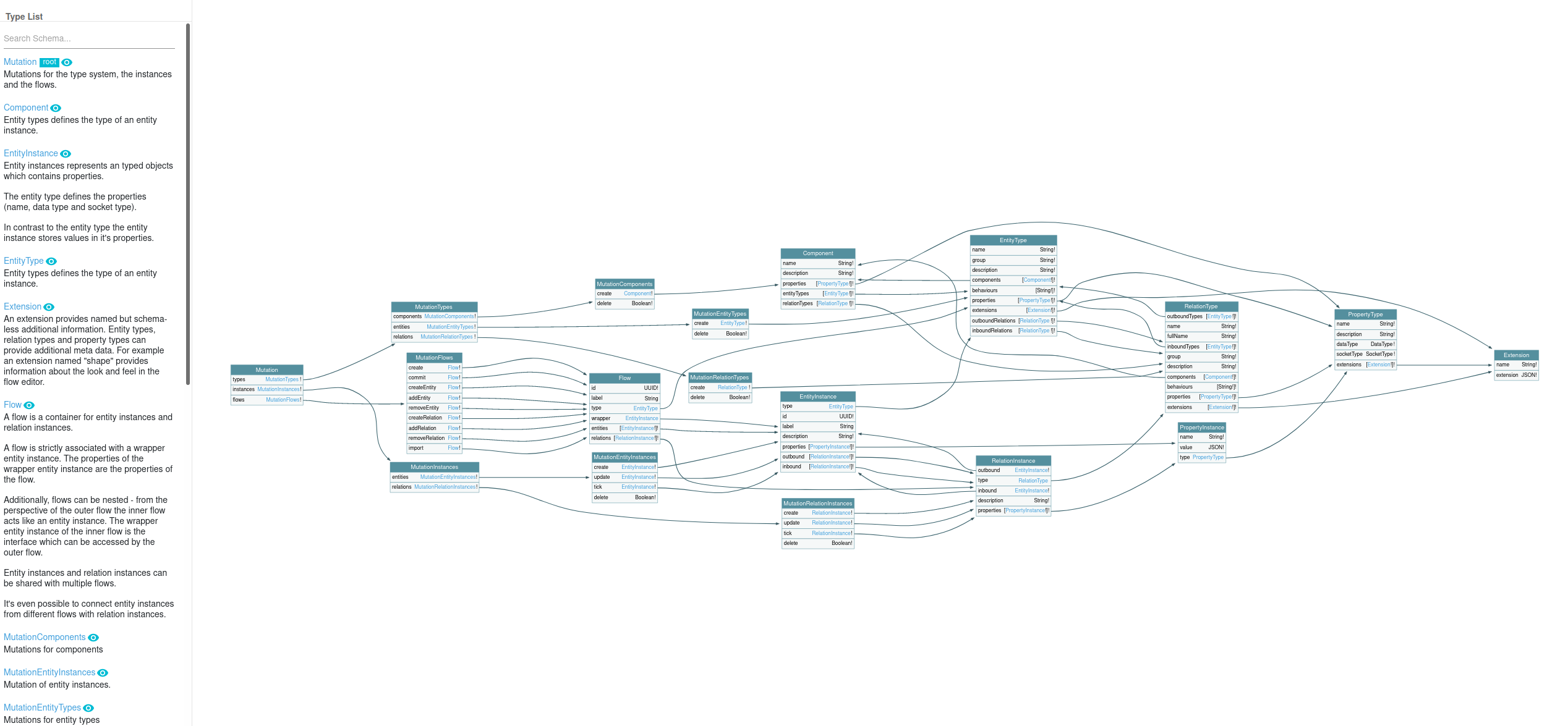➔ The Reactive Graph Flow is a graph database
➔ The Reactive Graph Flow is a document store
➔ The Reactive Graph Flow is a flow control runtime
➔ The Reactive Graph Flow is a web server
➔ The Reactive Graph Flow is pluggable and extensible
➔ The Reactive Graph Flow is fast, secure and small
➔ Game Entity Component System (ECS) - especially for Inexor
➔ Smart Home and Internet of Things
➔ Data Conversion Tools
➔ Flow Control System for card size computers and embedded devices
➔ Desktop Automation
➔ Content Management System
➔ Knowledge Graphs and Knowledge Processing
A graph organizes highly interconnected data. The state of an Entity Component System can be ideally represented
with the help of the graph. Inexor is the first game engine to introduce a graph as a basis.
The main benefits of a graph are:
- A universal data structure for everything
- Relations are first class citizens
- Benefit from types and instances which makes things intuitive
- Benefit from navigation which is fast and intuitive
- Benefit from the semantics of highly connected, intuitive data
- Properties can store not only certain primitive data but complete documents
Now that we understand how data is stored, here's how data interacts. The approach is that the data itself is "alive". To do this, Inexor adopts a concept from reactive programming.
In computing, reactive programming is a declarative programming paradigm concerned with data streams and the propagation of change.
It is the ingenious combination of a graph with reactive programming. The property instances are not static and only contain data. Rather, they are streams of data. If you change the value of a property instance, you fill the data stream of this property instance. Data streams are linked together. For example, if the stream of one property instance is linked to the stream of another property instance and you change the value of the first property instance, the value of the second property instance will automatically change as well. Data is thus propagated from one station to the next, triggering a cascade of propagations.
In addition, Inexor remembers the last value in each property instance. This is done by subscribing to your own data stream and caching it. This allows subsequent querying of the value of a property instance.
Remember this basic concept:
- Every property is a stream not only data
- Property streams can be subscribed and published
- The streams of two properties can be connected and changes will be propagated (cascade)
The data flow is therefore automatic. Building on this, Inexor applies the concept of behaviour-driven design. The goal is to use these data streams to simulate behaviour.
Behaviors can be implemented on components, entities and relations. To do this, one or more incoming data streams are combined, calculations are performed and written to one or more outgoing data streams.
For example, the entity type "AND gate" implements a behavior by subscribing to the two input properties, combining them into a combination data stream and performing an AND operation on the incoming pairs of values. The result of the AND operation is itself a data stream and this is linked to the output property.
This example shows how an entity type is wired internally. They are all data streams that are cleverly combined with one another and thus depict behavior.
It is interesting that this behavior also works for relations. For example, connectors are also implemented behaviors of streams. It is interesting that connectors connect the data stream from a property instance of the outgoing entity instance with the data stream from a property instance of the incoming entity instance.
For example the AND-Gate accepts inputs at the properties lhs and rhs. Both streams are subscribed and zipped. The zipped stream is calculated with a function - in this case the AND-Operator. This results in another (invisible) stream which is connected with the property result. The entity type AND-Gate defines that the properties lhs, rhs and result have to exist. Furthermore, the socket types are defined: lhs and rhs are Input-Sockets and result is a Output-Socket. The behaviour is like the internal wiring of entity instances and of relation instances. A behaviour can be added to entity instances and removed from entity/relation instances.
Control flows can be implemented based on the graph, the data streams and the behavior-driven design. It is important here that the available modules that implement the behavior are linked with connectors.
For example, a flow can consist of a logic that links several AND gates with each other using connectors. Both the AND gate and the connector are behaviors. But the arrangement of these behaviors within a flow makes them powerful.
Entire game modes can be implemented with the help of flows. Or just parts of it that are used in multiple game modes, such as a mechanism to pick up, drop, and score flags.
Flows are also useful for making maps more interactive. With the help of flows and behaviors, it can be ensured that a door opens in a map when you press switch 1 and switch 2. Or you determine the color of your own team's base based on the current score. Or you control particle emitters, depending on how many players are near the emitter. The possibilities for this are endless and want to be used!
Coming soon.









